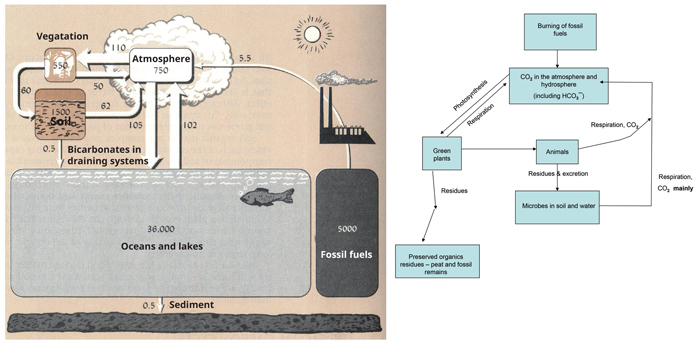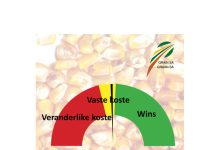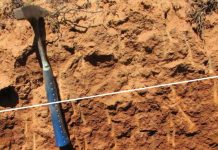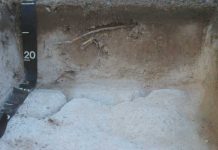Soil is the most fundamental resource for the farmer, without which food and natural fibre cannot be produced. This article forms part of a series to highlight this resource.
Organic material makes up only a small fraction of the soil, but it has a significant impact on the properties of soil. In the next few articles in this series on soil, we shall discuss this important fraction.
The organic fraction
The fixed phase of soil comprises inorganic minerals (sand, silt and clay) and organic particles. The organic material content of soil in south Africa is typically lower than two percent and, in most cultivated soils, lower than 0,4%. And yet the organic material has a significant impact on soil properties.
Organic material mainly comprises carbon (C) hydrogen (H), oxygen (O), phosphorus (P), nitrogen (N) and sulphur (S), as well as a number of other elements which occur in smaller quantities. Plant residue (above and below ground level), soil organisms, dead animals and excreations of live animals, are all sources of organic material in soil. In the soil, the added organic material is broken down into more elementary components which, in turn, form humus. The water soluble products are normally leached out of the soil.
Humus
Humus refers to the colloidal (very small) organic material in soil which offers resistance to further breaking down and usually gives soil a brown or black colour. Typically, it is the upper 200 to 300 mm of the soil profile that is enriched and coloured darkly by humus. When organic material is added to the soil, it serves as a source of nutrition for all the soil fauna and flora. It is broken down to the basic organic components. These basic components then bind together into complex compounds to form humus. Humus is therefore an organic product that forms in the soil. Humus colloids can bind with silicate clays to form relatively stable organo-clay complexes. In the process, mineral particles are bound together by organic fractions to form stable larger structures (aggregates) (Table 1).

(Source: Brady, NC. 1990).
Organic humus colloids have a higher specific surface, higher electrical charge density and higher cation exchange capacity. Humus is therefore chemically very reactive in soils and therefore changes constantly.
Functions of organic material in soil
Organic material promotes plant growth through its effect on physical, chemical and biological properties of soil:
- It has a nutritional function as it provides nitrogen in particular, but also other nutritional materials for plant absorption;
- It has a physical function as it promotes the soil structure and, in so doing, it also promotes tillability, water infiltration, aeration and the water retention ability;
- It has a biological function as it has a significant impact on the activity of soil micro-fauna and -flora.
Humus also plays an indirect role in soil as it influences the absorption of micro-nutritional elements by plants, as well as enhancing the effect of weed killers and other agricultural chemicals. The effect of this will naturally differ from one type of soil to another and will also be dependent on environmental factors such as climate and the history of tillage.
Plant nutritional materials
Organic material has both a direct and indirect effect on the availability of plant nutritional materials. Organic material is a source of N, P, S and other plant nutritional materials, when the organic material is mineralised (broken down) by micro-organisms. Humus can also influence the provision of nutritional materials from other sources by, for example, serving as an energy source for bacteria that attach N.
Effect on physical and chemical properties of soil
Intensive tilling leads to the break-up of the natural structure of the upper layer of soil. This break-up in the structure is the result of the mineralization of humus. As a result of the break-up of the structure, the upper layer of soil hardens, closes up with rain showers, and becomes denser and lumpy. Aeration, water infiltration, water retention ability and drainage therefore benefit from healthy humus levels.
The regular addition of organic material leads to the formation of organic complexes which bind together soil particles in crumbly and granular structures. These aggregates help to create a loose, open and receptive structure. Water infiltrates and drains better and is also stored better. Larger pores lead to better gas exchange between the soil and the atmosphere. This leads to better oxygen provision to plant roots, which is needed for root respiration.
Colloidal humus contributes 20 to 70% of the cation exchange capacity of upper layer soils. (Humus has a CEC of about 200 cmolckg-1.) That while the acidity varies between 3 and 14 cmolckg-1.
Effect on soil biology
Organic material is a source of energy for both soil fauna and flora. The numbers of bacteria, actinomycetes and fungi is determined to a large extent by the humus content. The number of earthworms and other fauna are strongly determined by the amount of fresh organic material in the soil. Certain organic matter, such as phenolic acids, is toxic for plants, while others such as auxins promote plant growth.
Organic material can also have a direct or indirect influence on pathogens in the soil. Adequate provision of organic material can benefit the growth of saprophytic organisms, while parasitic organisms are suppressed. Biologically active compounds such as antibiotics and certain phenolic acids can improve the ability of plants to resist pathogenic attacks.
The effect of tillage on humus
The humus content of the soil declines drastically during the first ten to thirty years of tillage, until a new quilibrium is reached. With equilibrium, humus forms at the same rate as that which is lost through mineralisation. In sandy soils, the degradation rate is rapid and this equilibrium is reached in about ten years and then at carbon levels of about 40% of the original. In loamy soils, the degradation is slower and equilibrium is only reached at about 20 to 30 years. In a warm, moist climate the degradation is quicker, while it is slower in a cool climate in particular.
Soil organic material and the carbon cycle
Sources of organic material in soils include plant residue, dead plant roots, dead animals, excretion from live animals and dead micro-organisms. This organic material is used as a source of energy by a variety of organisms and, in the process, the organic material becomes degraded. During the process, plant nutrition materials such as N, P, S and micro-nutritional substances are released via the process of mineralisation. Mineralisation is defined as the process through which organic molecules are converted into inorganic substances, while CO2 is released into the atmosphere. Some of the released substances can temporarily be trapped by micro-organisms via immobilisation. Soil therefore plays an important role in the global carbon cycle (Figure 1).

Fresh organic material mainly comprises hydrocarbons, proteins and fats, as well as smaller quantities of organic acids, lignin’s, waxes and rosin. The sugars and starches are degraded the quickest. However, hemicellulose and cellulose take longer. Proteins are usually broken down to form amino acids which are absorbed as is by microorganisms. Fats, lignin and waxes degrade slowly and therefore form an important part of organic material in the soil.
Should the C:N ratio of added organic material be greater than 25:1, all the nitrogen is absorbed by the micro-organisms and additional N is taken in from the soil. Therefore, a shortage of N in the soil occurs and the plants can experience an N shortage, the so-called nitrogen negative period. However, should the C:N ratio of the added organic material be less than 25:1, the excess N is released by the micro-organisms and it may be absorbed by the plants. The C:N ratio of fresh organic material is about 80:1, while that of soil organic material is 12:1. This is the main reason why organic material is composted before being worked into the soil. Should fresh organic material, with a high C:N ratio be worked into the soil, it is advisable to work N fertiliser into the soil at the same time, thus preventing the nitrogen negative periods.
Summary
Organic material is a highly important part of soil. Although it makes up only a tiny portion of the soil on a mass basis, it has a major effect on the physical, chemical and biological properties of the soil. It also has a major influence on the productivity of soil in terms of production of food and fibre for man and animal. Soil plays a significant role in the immobilisation of carbon out of the atmosphere. Degradation of organic material in the soil means immobilized carbon that is presently in the atmosphere. Farming practice should therefore focus on conserving carbon in the soil and accumulating it.
For further information, please contact the authors on:
Martiens du Plessis: 072 285 5414 / martiens@nwk.co.za
Prof Cornie van Huyssteen: 051 401 9247 / vhuystc@ufs.ac.za
REFERENCES
Brady NC. 1990. The nature and properties of soils. 10th ed. Macmillan publishing company, New York.

















